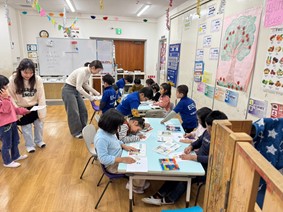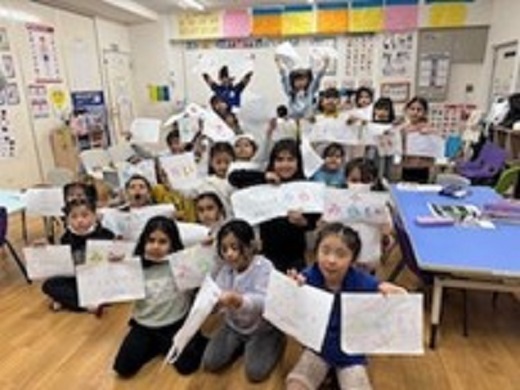[School of Global Japanese Studies]“Language Education” Practice for Nepalese Children by Kishi seminar
Apr. 17, 2025


The Kishi Seminar consists of seminar students who are interested in international cooperation and international educational cooperation and are engaged in activities both in Japan and overseas. As a part of such activities, the seminar is implementing educational practices in Japan in cooperation with Everest International School, Japan (IESJ), the first international school for Nepalese children in Japan.
Specifically, activities for “language education” using art methods have been developed and are being implemented in the kindergarten of IESJ, and in AY2024, third-year Kishi Seminar students NANJYO Ayane, SATO Haruka, MATSUDA Sayuka, OKABE Misuzu, and SUZUKI Ayami are developing activities.
The following is a practical report from the seminar students. The purpose of this activity was to deepen the Nepalese kindergarteners’ familiarity with the Japanese language by having them express how they feel about the Japanese language through colors.
▶︎ NANJYO Ayane (3rd year student)
I was in charge of facilitating the second year of kindergarten class. Through this activity, I directly felt that the children were learning while having fun, which gave me a warm feeling. I realized the essence of the performative approach to learning that the Kishi Seminar takes: “As we play together, we receive the children's reactions and flexibly make changes to the activities.” It was a practice that made me strongly feel the importance of continuing to create a place where children can challenge themselves by listening to their voices, movements, interests, and reactions rather than trying to proceed as planned.
▶︎ MATSUDA Sayuka (3rd year student)
I was in charge of facilitating the third year of kindergarten class. I have already visited more than 10 times since last year and interacted with the children many times, but through the painting this time, I was able to deepen my understanding of the children even more. Around the words, the children drew their own experiences and things they cherish. One child drew the Japanese flag because she wants to continue living in Japan, another drew the Nepalese flag because she wants to return to Nepal in the future, and a third drew a picture of herself working at a convenience store because she wants to work there like her mother. Through this work, we were able to see what the children were thinking and what they were seeing.
▶OKABE Misuzu (3rd year student)
I participated in the practice for both the second and third year of kindergarten classes this time, and I feel that there were both similarities and differences between the two classes, and I made many discoveries. I had never had any contact with the children, so I was curious about what kind of children they were, but also worried about how I should interact with them. However, when the children showed me their paintings, they asked me, “Why did you choose this color? I realized how important it is to have a conversation with the children and not just end with the painting. It was exciting to see how the children's backbone, thoughts, and ideas were visualized through colors, shapes, and paintings in the process of coming into contact with the language, rather than just learning and knowing the language.
≪Japanese version≫
Specifically, activities for “language education” using art methods have been developed and are being implemented in the kindergarten of IESJ, and in AY2024, third-year Kishi Seminar students NANJYO Ayane, SATO Haruka, MATSUDA Sayuka, OKABE Misuzu, and SUZUKI Ayami are developing activities.
The following is a practical report from the seminar students. The purpose of this activity was to deepen the Nepalese kindergarteners’ familiarity with the Japanese language by having them express how they feel about the Japanese language through colors.
▶︎ NANJYO Ayane (3rd year student)
I was in charge of facilitating the second year of kindergarten class. Through this activity, I directly felt that the children were learning while having fun, which gave me a warm feeling. I realized the essence of the performative approach to learning that the Kishi Seminar takes: “As we play together, we receive the children's reactions and flexibly make changes to the activities.” It was a practice that made me strongly feel the importance of continuing to create a place where children can challenge themselves by listening to their voices, movements, interests, and reactions rather than trying to proceed as planned.
▶︎ MATSUDA Sayuka (3rd year student)
I was in charge of facilitating the third year of kindergarten class. I have already visited more than 10 times since last year and interacted with the children many times, but through the painting this time, I was able to deepen my understanding of the children even more. Around the words, the children drew their own experiences and things they cherish. One child drew the Japanese flag because she wants to continue living in Japan, another drew the Nepalese flag because she wants to return to Nepal in the future, and a third drew a picture of herself working at a convenience store because she wants to work there like her mother. Through this work, we were able to see what the children were thinking and what they were seeing.
▶OKABE Misuzu (3rd year student)
I participated in the practice for both the second and third year of kindergarten classes this time, and I feel that there were both similarities and differences between the two classes, and I made many discoveries. I had never had any contact with the children, so I was curious about what kind of children they were, but also worried about how I should interact with them. However, when the children showed me their paintings, they asked me, “Why did you choose this color? I realized how important it is to have a conversation with the children and not just end with the painting. It was exciting to see how the children's backbone, thoughts, and ideas were visualized through colors, shapes, and paintings in the process of coming into contact with the language, rather than just learning and knowing the language.
≪Japanese version≫


